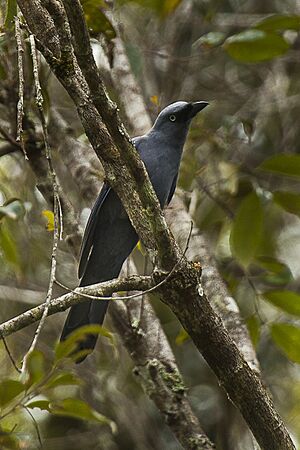Cerulean cuckooshrike facts for kids
Quick facts for kids Cerulean cuckooshrike |
|
|---|---|
 |
|
| Conservation status | |
| Scientific classification | |
| Genus: |
Coracina
|
| Species: |
temminckii
|
| Synonyms | |
|
Ceblepyris Temminckii |
|
The cerulean cuckooshrike (say: ser-OO-lee-an KOO-koo-shrike) is a special kind of bird. It belongs to a bird family called Campephagidae. This bird only lives on the island of Sulawesi in Indonesia. It likes to live in warm, wet forests, both in low areas and on mountains. People also call it the Sulawesi cuckooshrike or Temminck's cuckooshrike.
Contents
Discovering the Cerulean Cuckooshrike
A German scientist named Salomon Müller first wrote about this bird in 1843. Its scientific name, temminckii, honors a Dutch scientist named Coenraad Jacob Temminck. He was in charge of a big museum in Leiden and sent Müller to collect animals.
There are three slightly different types, or subspecies, of this bird. Each type lives in a different part of Sulawesi:
- C. t. temminckii lives in the northern part of Sulawesi.
- C. t. rileyi lives in central and southeastern Sulawesi.
- C. t. tonkeana lives in eastern Sulawesi.
What Does It Look Like?
The adult cerulean cuckooshrike is easy to spot. It grows to be about 30 cm (12 in) long. The male bird is a pretty grayish-blue color. Its wings and tail have a bright cobalt blue shine.
Where Does It Live and What Does It Do?
The cerulean cuckooshrike lives in old, untouched forests. It also lives in forests that have grown back after being cut down. You can find it in forests up to about 2,000 metres (6,600 ft) high.
These birds often fly around in small groups. Scientists believe they mostly eat insects. We do not know much about how they raise their young. However, young birds have been seen in October. You might be able to spot this bird in the Gunung Ambang Nature Reserve.
Is It Safe?
The cerulean cuckooshrike is quite common in many parts of central Sulawesi. It is a bit less common in the north and east of the island. The number of these birds seems to be staying steady. Even though it only lives in one area, the IUCN (a group that checks on animals) says it is of "least concern". This means it is not in danger of disappearing.


